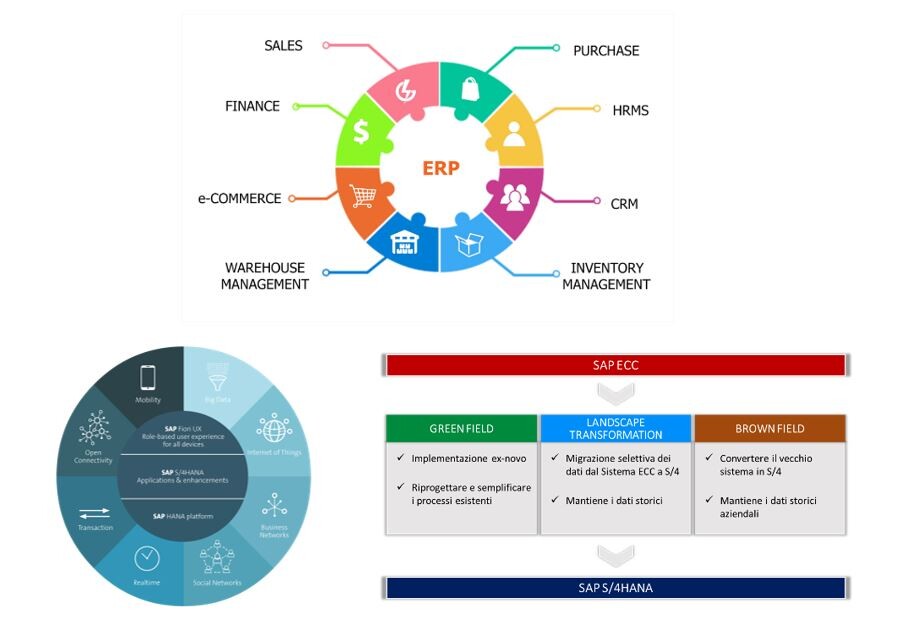AUTHOR: Ing. Leonardo Massaccesi
TUTORS: Ing. Giovanni Franchi
INTERNSHIP: Accenture
MASTER: Master in “Project Management delle opere strutturali ed infrastrutturali” a.a 2019/20
Il seguente elaborato, nella prima parte, effettua una veloce panoramica dei sistemi ERP, dalla loro nascita alla propria evoluzione, evidenziando le principali differenze che ci sono tra i due ultimi sistemi SAP ECC e SAP S/4Hana ed i diversi metodi di migrazione.
Nella seconda parte invece, accenna al ciclo di vita ed alle caratteristiche di un progetto, alla complessità e al ruolo chiave che riveste il Project Manager con gli strumenti e informazioni resi disponibili grazie al project management, ai processi di Project management ed alle proprie aree di conoscenza.
Per ultimo si discute del progetto di tesi, svolto in Accenture, azienda di consulenza leader del settore IT, nel quale si è svolto il progetto di migrazione in SAP S/4Hana per un cliente del settore aeronautico. A questo proposito, si affronta la metodologia SAP Activate per svolgere la migrazione (Prepare, Explore, Realize, Deploy e Run), i tool utilizzati per la migrazione da SAP ECC a SAP S/4Hana (SAP Data Services/BODS e LTMC), la suddivisione in Mock del progetto, le milestone progettuali, gli oggetti di migrazione con particolare attenzione alle anagrafiche materiali e allo stock, il processo di validazione dei dati e le diverse problematiche incontrate durante il progetto.
Una delle fasi che ha creato maggiori difficoltà è stato quello di coordinare i vari oggetti tra loro a causa della propedeuticità che alcuni avevano su altri. Questo aspetto infatti è stato un punto cruciale in quanto, è dalla buona coordinazione dei vari oggetti che si potevano ottimizzare i tempi di estrazione e caricamento dei dati.
Essere parte sia del team di Project Management che in quello di funzionali Operations, mi ha permesso di acquisire ed incrementare sia le hard skills che le soft skills necessarie per lo svolgimento di un ruolo così importante all’interno di un progetto.
Grazie a questa esperienza ho potuto prendere consapevolezza di ciò che significhi la gestione di un progetto complesso, nel quale le parti interessate sono numerose e gli elementi da considerare non sempre sono chiaramente identificabili.
FOR INTERNATIONAL STUDENTS:
In the first part, the following work gives a quick ERP system overview, from their origin to their evolution, highlighting the main differences between SAP ECC and SAP S/4Hana and their different migration methods.
In the second part there are the life cycle and characteristics of a project, the complexity and the key role that the Project Manager plays with tools and information available thanks to the project management, project management process and their areas of knowledge.
In the last part there is the thesis project made in Accenture. Accenture is a leading IT consultant company. The case study is a migration project in SAP S/4Hana for a customer in the aeronautical sector. In this part there are the SAP Activate method for the migration project (Prepare, Explore, Realize, Deploy e Run), the migration tool used in order to migrate the data from SAP ECC to SAP S/4Hana (SAP Data Services/BODS e LTMC), the different Mock of the project and the main project milestone, the migration objects with the details about material master data and inventory balance (stock), the data validation process and the different issue encountered during the project.
One of the phases that created the greatest difficulties was that of coordinating the different objects with each other, because some objects are mandatory for other objects. This was a crucial point, because it was from the good coordination of the different objects that data extraction and loading times could be optimized.
I was part of the Project Management team and Operations functional team, thanks for this, I was able to increase my hard skills and soft skills needed to do an important role as the project manager.
From this experience I was able to understand of what it means to manage a complex project, in which there were many stakeholders and the elements to be evaluated were not always clearly identifiable.



